Introduction
The development of occlusion and eruption guidance is an integral part of the speciality of paediatric dentistry. He (Paediatric dentist) has the responsibility to diagnose early about the potential irregularities in the developing occlusion, particularly premature loss of primary teeth and space closure and take appropriate measures to prevent malocclusion at the earliest possible time[1]. In 1998, Hoffding J and Kisling E reported that premature loss of primary teeth caused space loss[2],[3]. As a result of space loss, the permanent tooth may remain impacted or it may erupt buccally or lingually[4],[5]. The other causes for impaction of permanent tooth may be due to the presence of supernumerary tooth, ectopic eruption, arch length-tooth size discrepancy, trauma, odontoma and other problems[6],[7]. Therefore, one should thoroughly understand the various causes for it and investigate the various possibilities for impaction of a tooth and space loss in a child patient.
Space regainers are the devices used to move the desired tooth in mesial or distal direction to regain the lost space. Space maintainers are the devices used for preservation of the tooth space which is lost prematurely or a grossly carious, unrestorable primary tooth that has to be extracted. Both these appliances are used for proper eruption of the permanent tooth in their respective place. A simple but effective space regainer cum space maintainer appliance can be of great help to tackle with such a problem where there is impaction of one or two teeth. Space maintainer or space regainer is not new to the pedodontist but when we talk about dual function of the same appliance, perhaps it will be new to the speciality of paediatric dentistry.
Background
When there is premature loss of a primary tooth, the adjacent tooth moves into the extraction space causing space loss. In case of premature loss of primary second molars, the space closure is much more than premature loss of primary first molar. In such circumstances, where there is space loss (Figure 1), routinely we give a free coil spring appliance (Gerber appliance). Sometimes the appliance exerts too much pressure to the mesial tooth causing passive eruption of the same which is very difficult to control. This is more so when second permanent molar has erupted into the occlusion as a result the first permanent molar is not moving distally. The heavy force exerts through the appliance is sometimes uncomfortable for the patient too.
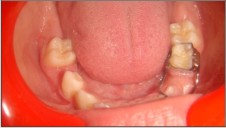 | Figure 1: Preoperative view of space loss.
 |
A simple 'U’ loop soldered on a band or a canine retractor soldered on a band will overcome all these difficulties. The appliance will provide good control of the tooth movement as well as force applied to the tooth. This new appliance can serve dual purposes of space regainer and space maintainer at the same time. Initially, the appliance is activated for regaining the lost space and then it is kept passive as a space maintainer in the same place till the tooth is erupted into the oral cavity.
Construction of the appliance
A suitable pre-formed stainless steel band is selected or a molar band is constructed over the first permanent molar with stock band material of 0.180x0.005 inch diameter. If the permanent molar is big, we can use thicker band material with a thickness of 0.006 inch. The latter band material is harder, and gives better stability of the appliance which should be used in older children because of difficulty in manipulation. After the band is made or selected, an alginate impression of the both arches are taken keeping the band in place. The models are made as usual with conventional dental stone keeping the band into the impression.
The wire bending for the space regainer comprises of either a canine retractor or a ‘U’ loop. The ‘U’ loop appliance should be made of 21 gauge of wire, whereas the canine retractor can be made with 22 or 23 gauge of wire. When we give two ‘U’ loops, one on lingual side and the other one on the buccal side, the wire should be of 23 gauge. The position of the 'U' loop or the canine retractor should be placed a little away from the band to avoid heating while soldering the appliance. The ‘U’ loop or reverse canine retractor can be soldered on either side of the tooth (buccal or lingual side) depending on space available, eruption pattern of the tooth and other conveniences (for example, the canine retractor can be soldered with a lingual arch space maintainer). The spring or the ‘U’ loop should be covered properly (boxing) with plaster to prevent heating while soldering the spring with the band. It is preferred to join the appliance with the band by indirect method of soldering. The activation of the appliance comprises of opening the ‘U’ loop or the coil spring of the canine retractor.
Indications:
Premature loss of single tooth and space closure. This appliance is most effective when there is space present mesially to the erupting or erupted tooth (usually first premolar) which can be moved into it.
Limitation:
Severe space loss with multiple impacted or unerupted teeth require comprehensive analysis and fixed orthodontic treatment. If a permanent first molar is to be distalised to regain lost space, extra-oral force with headgear may be considered.
Discussion:
It is not important to place a space maintainer or space regainer but one must thoroughly understand the tooth size-jaw size discrepancy, the bone covering above the developing tooth, its root formation, eruption of adjacent teeth, occlusion, oral habits and curve of spee for that particular child. Sometimes simple analysis of Nance or Moyers will help for space management and in other circumstances complex analysis of mixed dentition, cephalometric analysis, hand-wrist radiograph, growth analysis and prediction were essential[8],[9]. When the child is showing localised space deficiency and impaction of a second premolar, one must plan for simple space regaining appliance with free coil spring space regainer or Hawley’s type of appliance or expansion screw appliance or the appliance we just described.
The Pedodontist or Orthodontist often plan for serial extraction in the early mixed dentition period for crowding in the mandible or maxilla or both the arches. He immediately places space maintainer or holding appliance to prevent space loss. The minor crowding in the mixed dentition period can be corrected by preserving the lee way space according to Gianelly,1994[10]. In 1991, Arnold suggested that about 4.5 mm of crowding in the mandible can be corrected by holding the lee way space in 72% of cases[11]. Brennman and Gianelly (2000) supported the similar observation and suggested that mandibular incisor crowding was resolved in 60% cases with an average crowding of 4.85 mm[12]. All these authors used lingual arch therapy in all cases. We may not suggest using lingual arch therapy only in such moderate crowding cases as the average lee way space is 3.4 mm in the mandible and in the maxilla it is even less (1.8 mm). Further, the available arch length which is the distance from the mesial surface of the permanent first molar on one side of the arch to the mesial surface of the first permanent molar on the opposite side of the dental arch is continually decreasing. This is because of proximal wear and mesial movement of the permanent first molars during the late mixed dentition period[13]. There may be some increase of arch length by inter canine width also which might help for correction of crowding.
The depth of the Curve of Spee should be carefully noted and one must consider for more space require to make it flat because an ideal occlusion should have flat Curve of Spee according to Andrews LF, 1972. Generally,1mm of space required per side for correction of every mm of depth of curve of Spee[14]. In routine practice of paediatric dentistry, head plate correction of Tweed is also an important aspect. In this method, Tweed suggested that the mandibular incisors should be brought at 90 degree to the mandibular plane for better aesthetics, function and stability of the dentition when they are proclined[15]. Therefore, you need more space for their correction and comprehensive analysis is essential.
In the practice of paediatric dentistry we will mostly come across premature loss of deciduous second molars and impaction of the second premolars. When there was premature loss of primary first molar took place, there was minimum space loss and impaction of first premolar was less frequent. One should carefully note that there is minimum mesial migration of the permanent first molars took place when you will use the new appliance. Although there may be distal tooth movement of the permanent first molar too when you will use the new appliance. If the permanent first molar was too much mesially inclined, an extensive and comprehensive appliance should be designed to regain the lost space. This was very true for the cases where there was severe loss of space and there were multiple teeth impacted. For distalization of the permanent first molars or to make them upright, extra-oral anchorage might be required through head gear. The conventional free coil spring appliance may be ineffective in such situations because the mesial tooth may erupt passively as a result of excessive force.
Minor crowding (less than 3 mm) with straight profile can be easily corrected with space maintainers or space regainer preserving the lee way space or regaining the lost space. In such situations mostly we insert lingual arch appliance in the mandible or Nance appliance for the upper arch to preserve the lee way space[16]. In doing so, the minor crowding gets corrected with due course of time (self correction). However, if a child was having convex profile or there was severe crowding in the anterior segment of dentition, the anterior teeth must be moved backwards or they were aligned properly for better aesthetics and function, hence simple space maintainer or space regainer should not be given in these patients. In other circumstances, one may find that the space loss is severe and the occlusion is almost perfect, the impacted tooth needs surgical extraction and space regainer is not required. In this context what we mean to say that space management is more important than placing space maintainer or space regainer blindly in child patients.
In this paper we are presenting one case treated with the new appliance (Figure 1-7) although we have treated several cases with the same appliance. All patients are treated successfully with good results and the outcome is good because,
 | Figure 2: New appliance delivered.
 |
 | Figure 3: The impacted tooth is erupting into the oral cavity.
 |
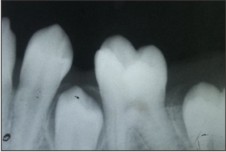 | Figure 4: IOPA radiograph showing space loss and impaction of 45
 |
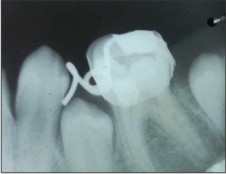 | Figure 5: IOPA radiograph- Immediately after insertion of the appliance.
 |
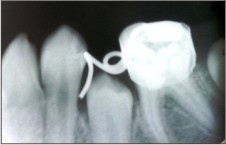 | Figure 6: IOPA radiograph -After activation of the appliance the tooth has erupted considerably
 |
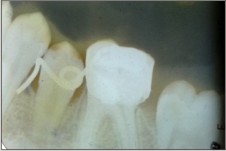 | Figure 7: IOPA radiograph -The impacted tooth has erupted into the oral cavity
 |
[Image 8]
1. The appliance is very much effective
2. It is simple
3. Patients compliance is good
4. Low cost
5. After regaining the space, it can be kept passive as a space maintainer till the tooth is erupted into the oral cavity.
6. When severe space loss has been taken place, it can be used for mesial movement of the mesial tooth followed by distal tooth movement of the permanent first molars with extra-oral head gear if required.
References
1. Dean JA, McDonald RE, Avery DR. Management of the developing occlusion. In Mcdonald RE, Avery DR and Dean JA eds. Dentistry for the Child and Adolescent, 8th edition, St. Louis, Missouri 63146.
2. Hoffding J,Kisling E. Premature loss of primary teeth: Part 11, the specific effects on occlusion and space in the permanent dentition. J Dent Child 1978;45:284-7.
3. Hoffding J, Kisling E. Premature loss of primary teeth; Part 1, its overall effect on occlusion and space in the permanent dentition. J Dent Child 1978;45:279-83.
4. Kisling E, Hoffding J. Premature loss of primary teeth: Part 111, drifting patterns for different types of teeth after loss of adjoining teeth. J Dent Child 1979;46:34-8.
5. Kisling E, Hoffding J. Premature loss of primary teeth: Part V, treatment planning with due respect to the significance of drifting patterns. J Dent Child 1979;46:300-6.
6. Peek S, Peek L, Katija M: The palatally displaced canine as a dental anomaly of genetic origin. Angle Orthod 1994; 64:249-256.
7. Chanshu S, Sharabi S, Beckar A. Dental morphologic characterstics of normal versus delayed developing dentition with palatally displaced canines. Am J Orthod Dentofacial Orthop 2002; 121:339-346.
8. Nance HN. The limitation of orthodontic treatment. I. Mixed dentition diagnosis and treatment, Am J Orthod Dentofacial Orthop1947;33:177-223.
9. Moyers RE. Hand book of orthodontics, ed 4, Chicago, 1988, Mosby.
10. Gianelly AA. Crowding: Timing of treatment. Angle Orthod 1994;64:415-8
11. Arnold S.Analysis of Leeway Space in the mixed dentition (thesis). Boston, Mass: Boston University;1991.
12. Brennan MM, Gianelly AA. The use of lingual arch in mixed dentition to resolve incisor crowding. Am J Orthod Dentofacial Orthop 2000; 117:81 -5.
13. Moorrees CFA. Growth changes of the dental arches: a longitudinal study, J Can Dent Assoc 1958; 24:449-457.
14. Andrews LF. The six keys to normal occlusion 1972; 62: 296-309
15. Tweed CH. The Frankfort-mandibular incisor angle1 (FMIA) in orthodontic diagnosis, treatment planning and prognosis, Angle Orthod 1954; 24:121-169.
16. Moore TR, Kennedy DB. Bilateral Space Maintainers: A 7-year Retrospective Study from Private Practice. Pediatr Dent, 2006; 28: 499-505.
17. Johnsen DC. Space observation following loss of mandibular first primary molars in mixed dentition. J Dent Child 1980; 47: 24-7.
18. Kupietzky A, Tal E. The Trans Palatal Arch: An Alternative to the Nance Appliance for space maintainance. Pediatr Dent, 2007;29:235-8.
|